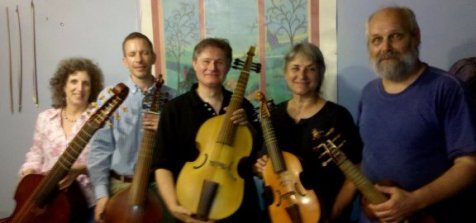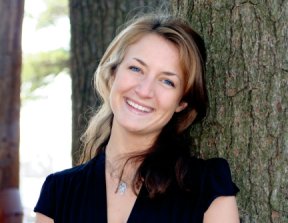2005 | 2006 | 2007 | 2008 | 2009 | 2010 | 2011 | 2012 | 2013 | 2014 | 2015 | 2016 | 2017 | 2018
Upcoming
2010 Events
Renaissance Songs and Dances
4:00pm Sunday
September 12, 2010
United Presbyterian Church
25 Church Street
Cortland, NY


Left to right: Susan Sandman, Lee Johnston, Toby Weinberg, Kate Cushing, Alex Rakov.
Photo at right: soprano Rebecca Leistikow
Cortland, NY
The Frogwork Consort will perform a concert of "Renaissance Songs and Dances" at 4pm Sunday September 12, 2010 at the United Presbyterian Church in Cortland. The concert will feature 5 violas da gamba and soprano Rebecca Leistikow. The consort songs are by William Byrd and the renaissance dances by Anthony Holborne.
Publicity and organizational support was provided by Cortland Music, Inc. with funds from a NYSCA Decentralization grant and the Ralph R. Wilkins Foundation.
Frogwork Consort
Kate Cushing is originally from Southern California and first played gamba with the UCR Collegium under Fred Gable. She also played cello in various music groups in the area. In 1978 Kate moved to Ithaca, New York and has played cello with Binghamton Symphony, Fingerlakes Symphony, and small chamber groups throughout the Southern Tier and has taught cello as well as Scottish bagpipes. She now studies viola da gamba and plays very happily with a group in Cortland, New York, under the direction of Alexander Rakov.Lee Johnston Lee Johnston studied organ with George Decker, David Craighead and Will Headlee. He studied viol with Alexander Rakov and has been a member of the Frogwork Consort since its formation.
Alexander Rakov started his music studies with violin at the age of 6. Later he studied composition and conducting, first at the Leningrad Conservatory of Music, and then at Syracuse University (with Brian Israel). He has been performing early music since 1975, first in the former Soviet Union, then in Europe, and since moving to the US in 1979 - throughout the states. He has taught early music collegium and instrumental performance at St. Lawrence University and Syracuse University. He has been a music director and then instrumental consort director of the Schola Cantorum of Syracuse since 1985. Many former and present instrumentalists involved with Schola became the members of The Frogwork, the group created in 1999.
Dr. Susan Sandman, an early music performer and musicologist who earned her B.A. summa cum laude in music from Vassar College and a Ph.D. in musicology from Stanford University, is Professor emerita of music at Wells College (Aurora, NY) where she started the collegium, wrote articles for academic journals, and collaborated on The Medieval Lady, a CD of music from the 12th through the 17th C. by women composers. She has performed widely as a recorder soloist and lute duet player with Elizabethan Conversation. She now lives in Ithaca and performs as well on viols with the Frogwork Consort..
Toby Weinberg grew up in a family well known in Syracuse NY for its involvement in early music. As an undergraduate Toby attended Manhattan School of Music and Syracuse University. He holds a BA in Fine Arts/Music History from Syracuse University and an MA in Computer Science, also from Syracuse University. Trained as a young man as a professional violinist and violist he was a founding member of the Syracuse Baroque Ensemble, one of the first “original instrument” ensembles in the area. Toby is one of the few American Hardanger fiddle players who has competed and placed well in traditional music competitions in Norway. A relative newcomer to viol playing, his involvement with the consort represents something of a return to his musical roots in early music.
A soprano known for her clarity of line and reaching interpretations, Rebecca Leistikow has performed as a soloist and choral singer throughout the U.S. and in Europe. She holds a Masters degree in Early Music from the Longy School of Music where she was a 2007 Honors Competition winner. While at Longy she studied voice with Jayne West and has also studied with Pamela Kurau at SUNY Geneseo. Rebecca has performed the roles Amahl in Menotti's Amahl and the Night Visitors, Galatea in Acis and Galatea by Handel, and, most recently, Serpetta in Mozart's La Finta Giardiniera. Rebecca has also sung with the Cathedral Choir of St. Paul in Boston and performs regularly with the early music ensembles Music for a while and Elizabethan Conversation. She now bases her music career in Ithaca, New York, as well as associate directing Wingspace Theater Company, and teaching voice.
Background
Viol consort music was typically composed for consorts ranging from three to six violas da gamba. The typical viol quartet of the Elizabethan and Jacobean periods (middle 16th to early 17th century), was one treble, one tenor and two bass instruments. In this same time viol sextets florished.The viol sextet, two trebles, two tenors and two basses, presents the most evenly balanced sound of any viol ensembles. While the smaller viol consorts, present single focused lines, the viol sextet achieves a relaxed, effortless richness of sound. The lines of counterpoint are often taken by pairs of instruments balanced against each other in elegant and subtle harmonies. This creates a spacial richness to the sound which has led some to consider the six part viol consort the most perfect ensemble of its, or perhaps of any age. Hearing this sound in concert is an all too seldom thing.
This is the quintessential chamber music, personal and intimate in its expression. Recorded performances, like two dimensional pictures of three dimensional objects, rarely do it justice. Like a fine sculpture, which gains from viewing in the round, when this music is experienced up close, more appears. In viol consort music, themes pass from viol to viol. As when looking at baroque sculpture, the audience can see movement through space as they watch melodies move from instrument to instrument, and listen to the subtle changes.
